Jan is a broadly-trained and multi-talented artist, and NWSSA has been most fortunate to have her as a member, teacher, and board member over many years. Her varied contributions have added a great deal to the vitality of the organization. Now, we get a chance to learn about her interesting life.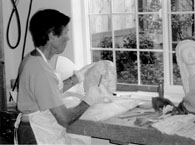
LE: By way of introduction, was there a key experience in your life that influenced your direction in art?
JB: Before I turned four, my younger sister and I, after losing both our parents in a boating accident, went to live with our grandparents who raised us. Looking back, I realize I found great comfort as well as recognition in my art endeavors which I continued to develop, starting with drawing and painting and soon getting into three dimensional work with clay, which was my favorite.
LE: Why did you become an artist?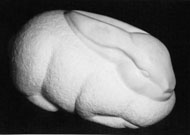
JB: I don’t think I became an artist, I think I always was an artist. I believe there is the artist in every one of us and it is expressed in many and very individual ways. In high school I worked on layout and photography for the school paper and yearbook while holding a part-time job at an art and photo shop, doing matting and framing. In college I majored in Fine Arts with an emphasis in sculpture. As I raised a family, I kept my hand in sculpture, aided by an encouraging and supportive husband. I apprenticed with one of my classmates from college who had gone on to teach sculpture, as well as developing his art. In his studio, I worked with wood, stone, and plastic.
LE: Who or what influenced your art work?
JB: Big influences in my art life were my life drawing Professor Francis DeErdely and sculpture professor Merrill Gage at the University of Southern California. NWSSA’s Everett DuPen was also a student of Professor Gage at U.S.C. about ten years earlier. (Merrill Gage has appeared on television sculpting, in clay, the head of Lincoln, who is shown changing from a boy to maturity and older.) After college my classmate, Robert Ortlieb, a well-known Southern California sculptor, was my mentor and teacher. I started teaching when he was ill and asked me to take over his class for sculpting in clay with a live model. I found I really enjoyed teaching and went on to hold classes of my own at the Palos Verdes Art Center and the Torrance Community Center. I continued teaching when we moved to the northwest in 1980 for the University of Washington Experimental College and for the Kirkland Art Center, and I also held private classes. I did find that it was hard to work on much of my own sculpture while teaching, but managed to get some sculptures completed.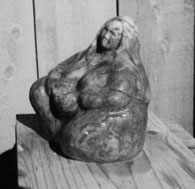
LE: How has the NWSSA influenced your work as an artist?
JB: I met Vic Picou a few years after moving to the northwest, and he encouraged me to attend meetings of the NWSSA. He got me interested in attending a Camp Brotherhood symposium after signing me up as one of the instructors. I was able to be of help instructing in many areas: form, anatomy, design proportion, etc., but I had done very little stone carving, so I was definitely a student in that area. I can remember how much there was to learn and what a wealth of information was there at Camp Brotherhood. But the mind-boggling part of it all was the generous sharing that poured forth and the wonderful acceptance from fellow carvers. The spirit and energy there was an inspiration like no other I had ever experienced. I soon found myself on the NWSSA board and on the committee to help plan future symposia. The experience over several years had a big influence on developing my stone carving knowledge and enthusiasm. There are a large number of stone carvers in the association whose work continues to be an inspiration for me.
Vic and I started the Whidbey Workshop ten years ago. It has always been a hand tool only carving symposium held in the lovely wooded retreat center of the Whidbey Institute on Whidbey Island. It is smaller than Camp Brotherhood with about twenty-five to thirty participants and two or three instructors. I plan each year to attend the Whidbey workshop.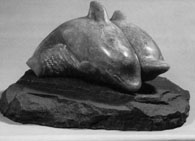
My trip with four other NWSSA members to the Tuscany area of Italy in the spring of 2000 was a dream experience. We set up carving tables under the shade trees outside the ancient building housing a former alabaster studio with tools available to us. This was on the ground floor with our modern apartments above. The setting was the countryside below the ancient walled city of Volterra, in the alabaster area. We spent our sunny Italian days alternately carving and sight-seeing for the three weeks we were there. We brought home one ton of beautiful alabaster and memories forever.
LE: Describe your art and explain how you develop your ideas.
JB: Most of my art is representational, but I have enjoyed doing a few abstract pieces. Some stones with a wild pattern call for semi-abstraction and simplification. I often use a clay model when developing a stone carving, but sometimes I’m very comfortable working directly. It depends on the stone and my subject. Many of my ideas come from nature, especially our surroundings in the northwest: sea birds, fish, animals, and also the human form, particularly dancers and their beautiful bodies in motion. Often I will work from pictures of dancing or of the animal world.
LE: What tools do you use?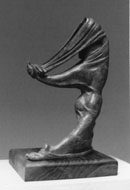
JB: My favorite tool is my pneumatic hammer and chisels. It gives me great control, and I find it easy to use. The water-fed grinder and polisher are great for finishing most stones. The angle grinder is helpful, but I use it with caution as it removes material so quickly. I also enjoy using hand tools on softer stones.
LE: Do you work part, or full-time as an artist?
JB: I work sporadically, definitely part-time. We have moved six times since coming to the northwest in 1980, and I find each move is a disruption to my studio time and momentum. Our last move, almost a year ago, had us moving into a new home with a large unfinished daylight basement. It makes a great studio space that is now set up, and I’m starting to make chips and dust. Perhaps I’ll get some of my pieces finished: the frog, loon, horse head, torso, etc.
LE: Is it usual for you to be working on so many sculptures at once?
JB: I always have several pieces in process. Sometimes I put a half completed sculpture away for a long time before I’m drawn back to it, often changing it dramatically. Most of my stone sculptures are thirty to sixty pounds because it is a size that I can handle.
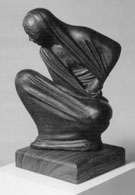
LE: What is your favorite stone?
JB: I have worked in soapstone, alabaster, marble, chlorite, and granite. My preferences are alabaster, chlorite, and marble.
LE: Have you been influenced by any particular artist?
JB: I found the movement and choreography of the Martha Graham dancers fascinating, and I was eager to translate that grace and movement to three dimensions; first in clay then in bronze. I love the challenge of capturing movement in any of the three dimensional media.
Quite a few years ago my husband and I visited Norway and toured the Vigaland Sculpture Park in Oslo. We were in awe of his striking multi-figured heroic sculptures, gates, columns, and family groups with a beautiful and powerful flow of movement.
LE: Where do you exhibit your work?
JB: When we lived on Whidbey Island, I exhibited at the Co-op Gallery in Langley. It was a wonderful exposure for my pieces, and I sold most of what I exhibited there. I was very busy producing art at that time, as well as teaching figure sculpture classes. I’ve sold several pieces since being on Lummi Island, part of them from a commission for the new Fish Market Restaurant in Irvine, California. Over the years I’ve produced ceramic fish plaques and large wooden relief carvings of their fisherman logo for most of their other eight restaurants.
LE: In addition to stone carving, do you pursue other forms of artistic expression?
JB: Gardening has always been a strong interest. I have worked with plants and landscape design in the many areas we have lived. The latest has been a garden area on Lummi Island that I planted in various, many-colored grasses and incorporated large driftwood log formations from the beach.

LE: Describe a recent piece or two.
JB: One of my favorites is a small torso of hard black Alaskan Lace marble. It has a lacey pattern with irregular white circular shapes. Because of the pattern, I kept the shape simple suggesting the female torso, and I left the original barnacles that were on the top of the stone. It is mounted on a black fossilized limestone base. I call it “Sea Nymph”.
I’m finishing up a white and gray horse head that I started in Italy. The stone is beautiful, and I’m looking forward to its taking a beautiful polish. A favorite earlier piece was a white marble rabbit, all textured except for the head and ears. It sold, and I have a piece of marble ready to make one similar that I will keep.
LE: What obstacles and challenges have you overcome?
JB: Who says I’ve overcome them? But I am trying. I’ve always been a very physical person. I love to ski, kayak, play tennis, etc. Since moving to Bellingham, I’m playing a lot more tennis and the physical workout supports a high energy level. My challenge at this time is to balance my activities so that I create a daily rhythm that allows enough studio time for carving on a regular basis. I also need to slow down and finish what I have started before being seduced by a new stone.
LE: What have been your satisfactions in your life as an artist?
JB: It is a joy and satisfaction to produce a lovely piece of art work, and I take pleasure in sharing the process with others. My sculpture teaching career has been most satisfying, and I am very proud of the occasional student who has developed into a serious and committed artist. I’ve always been amazed at how creative and talented each individual student can be. Many never dreamed they had such capabilities.
Finally I would like to share Chris Glaser’s poem with you:
Holy Creator
thank you for artists:
visual, verbal,
musical, kinesthetic, spiritual —
within their creative process
may we recognize the divine in all creation
and be moved to awe
and wonder and worship.

